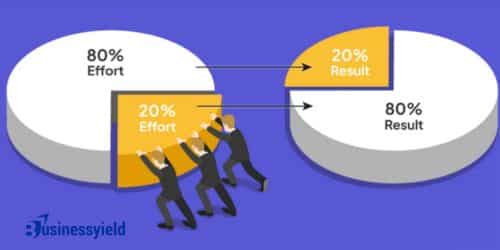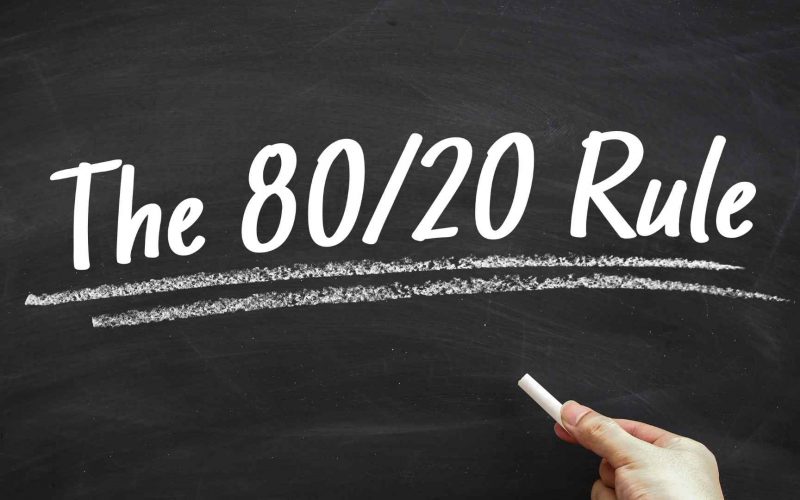You have poured your heart and soul into creating the ideal marketing campaign. So after you’ve thoroughly researched your target demographic and created appealing content, you distributed it through several platforms. But weeks later, the outcomes are disappointing. Sounds familiar? We have all been there. Marketing is a battleground; even the most smart campaigns can fail if your efforts are not directed in the correct areas.
This is where the Pareto Principle, or 80/20 rule, comes into play.
While the 80/20 rule is a well-known principle, many marketers struggle to turn it into a practical strategy. Here I’ll go beyond the surface and show you how you can use this idea to maximize your marketing ROI.
What is the 80/20 Rule?
The 80/20 rule, often known as the Pareto Principle coined by Italian economist Vilfredo Pareto in the early 1900s, states that approximately 80% of consequences result from 20% of causes. In the context of marketing, it implies that a tiny percentage of your efforts are likely to generate the majority of your results.
In 1895, an Italian economist released his results on wealth distribution, revealing that 20% of Italy’s citizens held 80% of the country’s wealth. Since Pareto’s results, other researchers have adapted his 80/20 rule of cause and effect—also known as the Pareto principle—to a wide range of contexts other than income distribution, such as business concepts and professional development. While 80/20 is the most popular ratio, the Pareto principle may also apply to other similar ratios, such as 70/30, 75/25, or 85/15. These numbers all indicate that a small number of factors influence or produce a large number of outcomes.
Key Takeaways
- The 80/20 rule, or Pareto Principle, suggests focusing resources on the 20% of efforts that yield 80% of results, especially in marketing campaigns and customer targeting.
- Identifying key performers in marketing campaigns, like specific ads or platforms, and reallocating resources towards these can significantly enhance campaign effectiveness.
- Tailoring marketing strategies to the top 20% of customers who generate the majority of sales can maximize customer engagement and revenue.
- Continuous assessment and reallocation of the marketing budget towards high-performing channels are crucial for maintaining efficient spending.
- Utilizing data-driven insights from web analytics and customer feedback is essential for identifying the “vital few” strategies that drive the most business impact.
Benefits of the 80/20 Rule
The 80/20 rule can help you determine where you should spend the bulk of your time, money, and energy. You can use it to help you set attainable goals, specify precise actions to achieve them, and stay focused on what has the greatest impact. Here are just a few benefits that the 80/20 rule offers:
#1. Improved time management
By identifying the tasks that produce the best results, you may plan your day to focus on those that have the greatest impact on your job. This can help you perform better, potentially enhancing your job. It can also help with work-life balance.
Read Also: TIME MANAGEMENT TOOLS: All You Need to Know
#2. More effective leadership
If you want to develop your leadership abilities, employ the 80/20 rule to allocate time for socializing with your team. The Pareto Principle could also help you function as a mentor at work. This can help you establish trust and team togetherness.
Read Also: EFFECTIVE LEADERSHIP: Meaning, Qualities & Skills
#3. Better utilization of firm resources.
The 80/20 rule can help you better use your company’s time and effort to perform things like:
- Research rivals or industry trends.
- Streamline hiring procedures.
- Improve the company culture.

Examples of the Pareto Principle
In business, this suggests that 80% of your profits are generated by 20% of your total sales. As a result, it would be beneficial to focus your efforts on the clients who account for 20% of your greatest sales.
As a marketer, I’ve probably discovered that 20% of my marketing messages produce 80% of your campaign results. Or, if you’re engaged in a huge marketing project, you may discover that 20% of your beginning efforts account for 80% of the result.
If you’re a financial advisor, you’ve probably seen that 20% of your clients account for 80% of your business profits. It could be advisable to focus on sustaining the relationship with those specific clients.
However, the Pareto Principle is not limited to overall outcome observations.
Instead, the 80/20 Rule may be used in almost every aspect of your workplace to assist maximize your efforts and productivity.
How to Apply the 80/20 Rule to Your Advantage
According to the 80/20 Rule, 20% of your efforts provide 80% of your results.
When it comes to productivity, the Pareto Principle does not necessarily imply that you should only work 20% of the time or go into the office once a week.
It is important to emphasize that the Pareto Principle does not imply that you should work less.
Instead, when applying the 80/20 Rule to your workday, the Pareto Principle can assist you in determining which tasks you should prioritize to maximize your time and productivity.
In other words, focus your efforts on the most important activities and avoid becoming bogged down by little details.
There are numerous ways to implement the 80/20 rule in your organization. The following examples show how to apply the 80/20 rule to examine success and improvement aspects while maximizing efforts to accomplish results.
#1. Make Business Decisions
The 80/20 Rule can also assist you make challenging business decisions. Perhaps you have a list of projects for various clients, but you’re running out of time. If the 80/20 Rule holds, you should devote your time and energy to pleasing and creating solid relationships with the 20% of your clients who produce the most outcomes for you.
This is not to mean that you should be unprofessional or disrespectful to other clients. However, if you are feeling overwhelmed or short on time, it may be beneficial to identify where you are getting the best results and devote your time and attention to those clients.
To do this you might need a customer segmentation template to help you adequately identify the top 20% customers to focus on. You can use our free template below.
This template helps marketers focus their efforts on the most profitable customer segments, ensuring that they are targeting their resources for maximum effect. It’s also flexible enough to be adapted to different industries and customer bases.
The Pareto Principle can also assist you in considering business issues and potential solutions. To use the Pareto Principle to solve your problem, consider all feasible answers and work backward. You’ll want to focus on the two best solutions for your situation.
#2. Revenue Identification
Applying the 80/20 rule to business provides various advantages, particularly in terms of streamlining the company’s business model to invest in the people, products, and processes that generate the highest returns.
For example, Sam owns a modest business that has grown in popularity over the last year. To maximize his restaurant hours, Sam employs the 80/20 rule, discovering that approximately 15% of the restaurant’s hours generate 85% of the revenue. This 15% implies that his peak hours are from 7 p.m. to 9 p.m. Sam chooses to prolong his supper service by one hour to generate revenue during peak hours.
#3. Professional development
You may use the 80/20 rule to expedite your job search, target the most impactful prospects, and develop a strong professional network.
Rex, for example, is a marketing professional who has returned to work after four years as a remote farm researcher. He is looking for a career that will allow her to combine her market analysis skills with her interest in organic farming. Rex follows the 80/20 rule in his job search, spending 80% of her time looking for and applying to market research roles for fertilizer companies and 20% applying for other marketing positions in other industries. Rex uses this strategy to streamline his job search duties that are directly related to his desired career path while still keeping his choices open for other occupations that may lead to opportunities.
#4. Productivity
You can utilize the 80/20 rule to evaluate which chores have the greatest influence and optimize your productivity for maximum outcomes. Use the Pareto principle to help you manage your time, finish key projects, set realistic deadlines, and increase your attention.
For example, Jolene works from home as a medical coder. Although she can choose her own hours, she often works late to meet deadlines. Jolene applies the 80/20 rule to determine which 25% of her daily tasks account for 75% of her week’s workload. She devotes 75% of her day to the most important things, which improves her time management and ability to meet essential deadlines.
#5. Customer Relations
Applying the Pareto Principle to customer interactions will help you determine the best ways to communicate with customers and understand how they affect business.
For example, Abby is a hairstylist who wants to boost her business. She applies the 80/20 rule to determine that 80% of her new clients were referred by 20% of her existing clients. Abby employs this word-of-mouth advertising method, offering discounts to clients who recommend others to schedule appointments with her. This approach can help her grow revenue, strengthen customer connections, and devote more time to studying new styling techniques.
Avoiding the Pitfalls of the Pareto Principle.
The Pareto Principle, like all other principles, has some downsides.
It’s crucial to understand that the 80/20 Rule does not mean lowering your workload. Instead, the Pareto Principle can help you find the most important, high-impact things on your to-do list. However, do not ignore minor or insignificant jobs. If you put off those simple duties for too long, they will become more significant.
If you manage a team, the 80/20 Rule might assist you in determining which people are producing the most work. Looking at the 20% of employees who do 80% of the work does not necessarily imply that you should terminate everyone else. Instead, use the Pareto Rule’s findings to equitably distribute duties among your team members.
Encourage your staff to work together on high-priority initiatives. Alternatively, assign different jobs to different people and check in with everyone to ensure they feel accountable for their side of the equation. Your employees will be motivated to work harder if they believe they are contributing to the most significant portion of the rewards—not just the tiny details.
Data-Driven Approach to Applying the 80/20 Rule
So, how do you determine your marketing’s “vital few?” The solution is facts combined with a dash of creativity. Here are some actionable steps to help you get started.
#1. Web Analytics
Check your website analytics to see which pages and landing experiences create the most leads and conversions. Are there any particular blog entries that are receiving high-quality traffic? Are some product pages converting visitors at a significantly higher rate? Discovering these insights can reveal hidden gems in your current content strategy.
#2. Campaign Performance Analysis
Don’t only monitor clicks and likes. Analyze the effectiveness of your marketing activities across several platforms. Is your sponsored advertising on Platform X generating more qualified leads than Platform Y, despite a similar budget allocation? Shifting resources to higher-performing channels can drastically boost your marketing ROI.
#3. Customer Feedback Loop
Never underestimate the power of your customers. Conduct surveys or focus groups to see how people find your brand and what material resonates with them the best. This useful client feedback might throw light on unanticipated marketing channels or techniques that are producing results.
Is the Pareto Principle Always Effective?
The Pareto Principle, sometimes known as the 80/20 Rule, is largely accepted as valid. However, this is not based on scientific analysis. Rather, its legitimacy is based on anecdotal evidence. As such, the principle is an observation rather than a definite law.
How Do I Use the 80/20 Rule to Invest My Money?
The 80/20 rule can be used to a variety of situations, including how you invest money. When it comes to investing, the principle emphasizes selecting the correct assets to balance risk and reward. That being stated, you’ll want to optimize the 20% of your portfolio that generates 80% of your gains.
Your investment style and approach will determine how you apply the theory. For example, you may want to allocate 80% of your portfolio to safe assets and 20% to risky classes. Consider discussing with a financial adviser how to use the Pareto Principle in your investment strategy.
Conclusion
It’s vital to understand that the 80/20 rule is not a set formula. As your business grows and marketing landscapes change, the “vital 20%” will evolve. The goal is to adopt a data-driven, iterative approach to marketing, constantly testing and adjusting your strategies based on real-world results.
The 80/20 rule is a useful tool that may be used in a variety of marketing strategies. From content development to budget allocation, this idea can help you focus your efforts on the activities that have the most impact.
By embracing the 80/20 rule and using a data-driven strategy, you can turn your marketing into a strategic weapon. Are you ready to identify your marketing “vital few” and achieve new levels of marketing efficiency?
- Empowering Efficiency: How Organizational Structure Impacts Your Business Growth
- Copy These Campaigns! 7 Marketing Plan Examples That Crushed Their Goals
- Harnessing the True Potential of Backlinks for Business Growth: The Backbone of SEO
- 5 Steps to Crushing Your Competition with Content Strategy






